Written by Guest Contributor on The Prepper Journal.
Editors Note: Another article from Paul Taylor to The Prepper Journal. As always, if you have information for Preppers that you would like to share then enter into the Prepper Writing Contest with a chance to win one of three Amazon Gift Cards with the top prize being a $300 card to purchase your own prepping supplies!
Like many preppers, I was a Boy Scout. My dad had been a Scout and was one of my Scoutmasters during my teens. He was a believer in safety, security, being careful, having the right gear and tools, and knowing how to use them. He knew a lot about survival, mostly the hard way, from his service on the ground as a combat infantryman in the South Pacific during World War II. So I got a lot of hands-on training from him, at home and in the field. One of his pieces of wisdom was that you should have a safe, reliable car and carry whatever you might need in it. He didn’t have the benefit of the hundreds (if not thousands) of prepper articles I’ve read over the years, so I’ve taken his wisdom up a notch or two.



I can’t claim to be a definitive expert, but I’ve done a lot of reading and thinking on all of this and I have a lot of miles under my belt. I believe that this is a solid distillation of many different approaches into a rational and comprehensive car emergency kit, at least the one that works for me and my needs. Obviously, different circumstances and geography mandate different solutions. I live in the suburbs of a major metropolitan area, but I drive widely on trips, often in remote areas. I want to be sure to have on hand what I might really need wherever I end up, especially where I’m not in easy reach of civilization. Take from this whatever works for you, leave what doesn’t, adapt it to your needs.
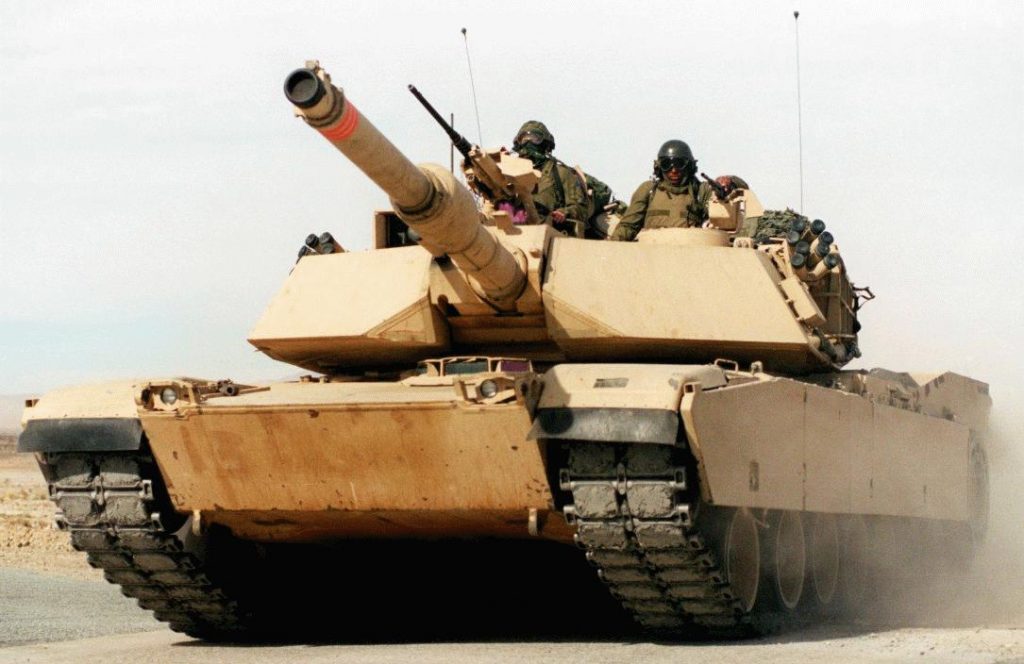

First, I make sure I have a safe, reliable car, crossover or SUV with all-wheel drive, an elevated frame and a roof rack or carryall for additional capacity. I tend to need more capacity on the roof because my trunk area starts out at half full with my emergency bag and car kit. I like having a crossover or SUV that rides high because I once had an encounter with a too-high rock that cracked my radiator and cost me a lot of money and heartache. I like all-wheel drive because we’ve had some severe winters that made roads impassable for normal cars. I have to have a safe car because the people most precious to me are riding in that vehicle, and I want them to have the best chances of surviving an accident that I can provide, short of an M-1 Abrams tank or Hummer. Twenty and thirty years ago I bought Volvo’s, back when they were affordable, amazing in snow and the safest things on the road. Now they’re a luxury brand, and a whole range of other brands match their old safety and reliability at half the new cost. In my mind, spending a little more money to ensure that you survive – even walk away from – the accident that totals your car is a cheap insurance policy.
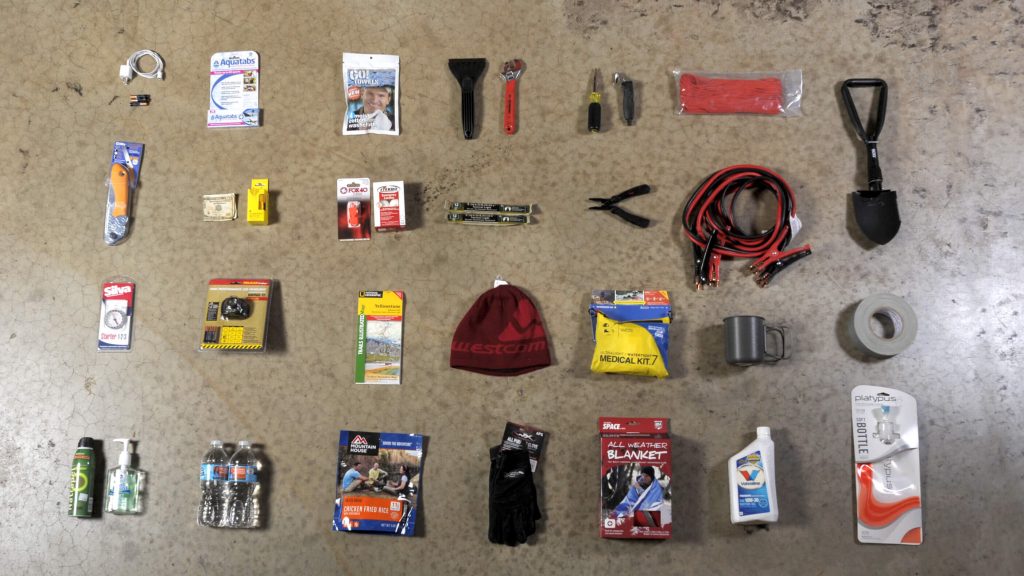
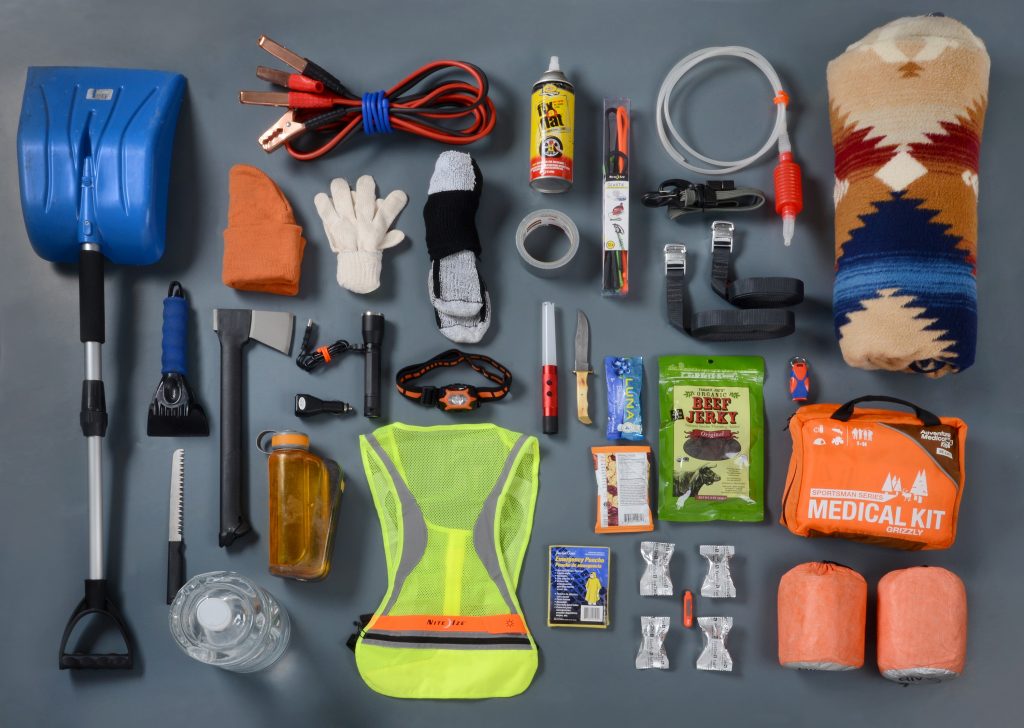

I’m a big believer in prepping for the most likely serious events where the right preps can make a huge difference. Plus there are space limitations for even the most well-thought-out car emergency kit.
First things first: a flat tire – the most common of problems. So I have a good jack, chocks for the wheels, an inflated spare (checked regularly), a tire repair kit for any issue that doesn’t ruin the sidewall of the tire, and an air compressor that plugs into the car and re-inflates the tire. That setup alone resolves the biggest and most likely issues you’ll encounter on the road and turns a multi-hour wait for a repair truck into a half hour’s complete repair, without the added stress of driving on a small donut spare and having to take your tire in for a repair that you can do yourself in ten minutes.

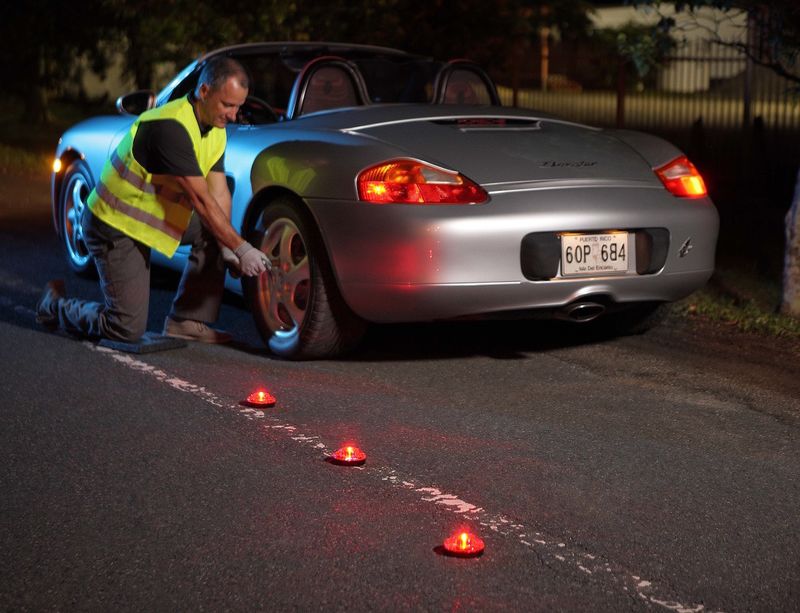
Working on changing a tire by the side of a highway is not for the faint of heart, so I try to minimize my risk of injury (or death) from an inattentive driver by setting up a reflective triangle and setting flares. I have one triangle, but I carry eight flares – just in case I need more than the ones I’ve already burned down. I also carry and wear a reflective vest. And the kit has two sets of leather work gloves for hand protection.
Needless to say, a prepper doesn’t run out of gas because he or she never lets the tank go below half full, but things happen, so I also carry a one-gallon plastic gas can and a gas siphon tube. The siphon lets you get gas from any car that’s willing to share, and the can collects it, or you can use the can in hiking to the nearest gas station.
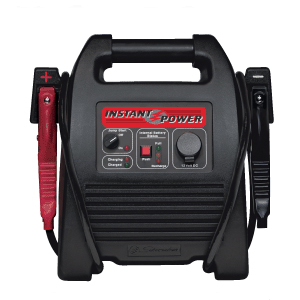

Batteries sometimes surprise us and lose their charge at inopportune times. I have a set of heavy-duty jumper cables, but more recently I’ve invested in a small but powerful battery with connected jumper cables so I don’t have to rely on someone coming by and being willing to jump my car (or me). I re-charge it every three months and haven’t yet found it discharged. And it can recharge my cellphone or other electronics in a pinch.
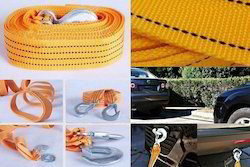
Another useful item is a heavy duty tow rope or strap. I once was driving down a narrow country road bounded by deep ditches and found a car in the ditch, axle deep in mud, unable to move, with two very unhappy young ladies next to it. My winter kit has a pair of wide plastic strips that give the wheels traction in snow (a couple of pieces of thick cardboard work almost as well), but this was summer and I sure didn’t want to get into that mud, so I just attached the tow strap to each of the cars, slowly pulling the strap taut, and pulled it out of the ditch. The owner of the car sent me a very nice bottle of bourbon as a thank you.
Sometimes there’s a cracked or leaking hose, so I have some self-fusing silicone wrap that is temperature resistant and holds anything closed. A spare clamp, or a zip tie in a pinch, can also help the repair. And because nothing burns up an engine faster than not having coolant, I carry a can of coolant to top off whatever has leaked. I also carry an extra quart of oil for much the same reason.
And to round out the self-help items, I keep a small auto tool kit in the car as well because not having the tool you need when you need it . . . .
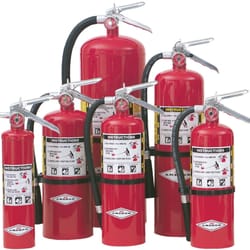

A fire extinguisher that I keep under the driver’s seat (not in the trunk in a bag where I can’t find it when I need it) is useful to have. I was once driving behind a car that was smoking badly. They stopped, blocking me, and opened the hood. Flames poured out. If I could have reached an extinguisher right then, I might have made a difference, but by the time I got out of the car and got to the trunk that car was merrily ablaze. So, in my humble opinion, having the critical tool at hand is key. Too late is too late.
For the same reason, I have an emergency escape hammer and embedded razor in my driver’s door compartment. If I need to cut open my seat belt and bash out my window, then I need that tool right then.
My winter kit adds a snow shovel, ice scraper and brush, the wide plastic gripper strips for ice, winter gloves, an extra down jacket, wool socks and boots, a wool cap, and a large can of kitty litter.

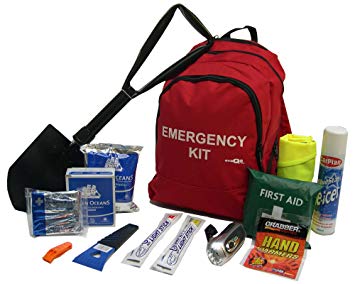
As preppers you are surely saying in disbelief “that’s all?” And I say in return that for the car emergency portion of the kit that is what I carry. But of course I also carry an overlapping and much larger emergency bag as well. And a fully stocked EMT-level first aid kit.
The car emergency kit mostly fits in two small bags: a tire repair and inflation bag with the compressor and repair kit; and a AAA bag with tools, jumper cables, gloves, reflective vest, flares, etc. Other parts of the kit are in their own cases (reflective triangle) or are corralled behind netting (liquids). And yet other parts of the kit are in the large emergency kit, which is a large and very full duffel bag.
The duffel bag emergency kit significantly expands the range of threats to which I can respond, essentially creating a car-worthy bug out bag that’s always there. It covers the basics: lighting, heat, food, water, shelter, survival tools, rain gear and communication. I think a list is most useful here so I’ll group the items.
Lighting – because off the road in the dark is dark
- 3 flashlights – small one in the glove compartment
- Lantern
- Flashlight that converts into a lantern and can attach to the car with a hook or a magnet
- LED headlamp
- 8 light-sticks
- 30 hour emergency candle
- Extra batteries for everything
- Plus a windup emergency radio that has a flashlight in it
Basic survival tools
- A sturdy and comprehensive multi-tool
- A sturdy, large folding knife
- A sturdy fixed blade knife
- A metal folding shovel
- A hatchet
- A commando saw
- A small pry bar or crowbar
Shelter and Weather Protection
- Small, compressed sleeping bag
- 2 emergency sleeping bags (Mylar)
- 2 emergency space blankets
- Heavy duty hooded weather blanket
- Wool blanket
- Emergency 2-person tent
- 4 plastic emergency ponchos
- 2 baseball caps
- 6’ x 8’ tarp
- Hand and toe warmers
- Down jacket and gloves
- Boots
Water
- 8 survival water packets
- 8 pint bottles of water (in car and bag)
- Nalgene water bottle
- Water treatment pills
- 2 gallon water bag
- Sawyer mini water filter
- 4-way water key (to open any exterior building taps)
Heat, cooking, food
- Collapsible stove with fuel tablets
- Mess kit
- Steel cup
- Tea bags, instant coffee, sugar packets
- 2 boxes storm proof matches
- Bic lighter
- 2 Datrex emergency rations
- 5 long life energy bars
- Large bag of trail mix
Communication
- Old cellphone with charging cable (can still call 911)
- Emergency AM/FM windup radio
- Emergency CB radio with antenna (in the process of upgrading to a small ham radio)
Hygiene
- Toiletry kit with soap, shampoo, toothbrush, toothpaste, etc.
- Toilet paper roll in plastic bag
- Insect repellent wipes
- Tube of sunscreen
- Large package of wet wipes
- Camp towel
- 13 gallon plastic garbage bags
Miscellaneous
- Emergency whistle with a button compass
- Metal whistle
- Compass
- Regional and state maps
- Orange glow tape roll
- Roll of duct tape
- Assortment of bungee cords
- 100 feet of 5-strand nylon paracord
- 2 contractor grade plastic bags
- 4 N-95 masks and nitrite gloves
- Rite in the Rain spiral notebook
- Space pen (waterproof ink) and Sharpies
First Aid
I don’t anticipate that I’ll ever need all of what I carry, but I’ve been through enough events where many of those items came in handy that I recommend serious consideration of the whole list.
A few simple examples:

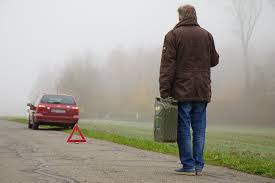
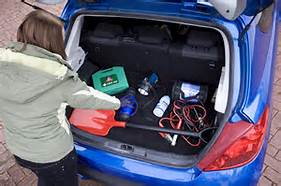
I once drove through an area that had a nearby forest fire. The smoke was choking thick, but I had an N-95 mask in the glove compartment, and putting that on made a huge difference in being able to breathe.
My wife had a small fender bender but thought she had no damage. Unfortunately, a day later we hit a bump and the driver’s side rocker panel of the car broke off, with the front digging a furrow in the road. The car was undriveable, and it was a Sunday afternoon in the country. She was not happy (to say the least), but I went to the kit and pulled out the trusty roll of duct tape. I taped the rocker panel back on and it lasted long enough to get us to the repair shop. Problem solved.
Another time, on a summer trip we were on a major interstate highway in the middle of nowhere when all traffic stopped dead, hundreds of cars stopped in the blazing sun and 100 degree heat with nothing around us but scrub forest. It turned out that an RV had caught fire on a bridge 20 miles ahead and the whole highway was shut down. So there we were, one of thousands of cars stopped on the highway on a brutally hot summer day with nothing around for miles. Cars were overheating, so the air conditioning went off for everyone and pretty soon everyone was suffering in baking hot cars or under the blazing sun. And of course no one had water or food. Except us. We draped our emergency reflective blankets across the front and rear car windows, and opened the doors and windows for air. We were relatively cool and, most importantly, shaded. And we had plenty of water and enough trail mix and energy bars to keep us full and happy for the four hours it took to clear the road and get us going again. The contrast with the people who had nothing in their cars was striking.

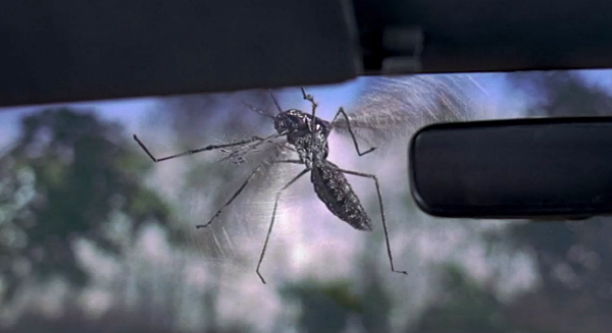
I don’t need to go through the obvious examples of a cap or sunscreen preventing a bad sunburn, or mosquito repellent protecting against nasty stings, or blankets or warmers or a down jacket keeping you warm in the biting cold, or boots instead of flip-flops when you have to hike for gas or help, or a commando saw cutting a tree that fell across the road, or even having a real map on hand when the GPS is lost. These are all real world problems, but in our comfortable and civilized world we rarely have to engage with them other than as a minor annoyance. But when finding your way is critical, when you’re miles from shelter in blistering heat or bitter cold, when you’re hungry and thirsty, getting sunburned or bitten – then knowing you have what it takes to fix the problem makes all the difference. My dad’s teaching and the Boy Scout motto – “Be Prepared.”
Follow The Prepper Journal on Facebook!
The post What Should Be in Your Car Emergency Kit appeared first on The Prepper Journal.
from The Prepper Journal
Don't forget to visit the store and pick up some gear at The COR Outfitters. How prepared are you for emergencies?
#SurvivalFirestarter #SurvivalBugOutBackpack #PrepperSurvivalPack #SHTFGear #SHTFBag

No comments:
Post a Comment